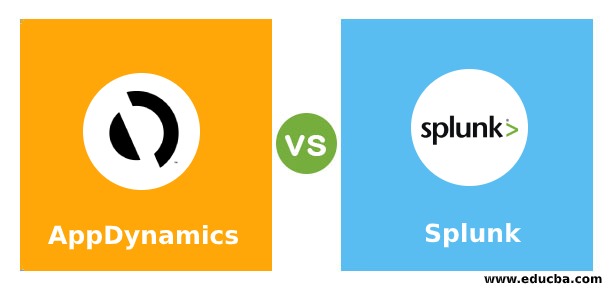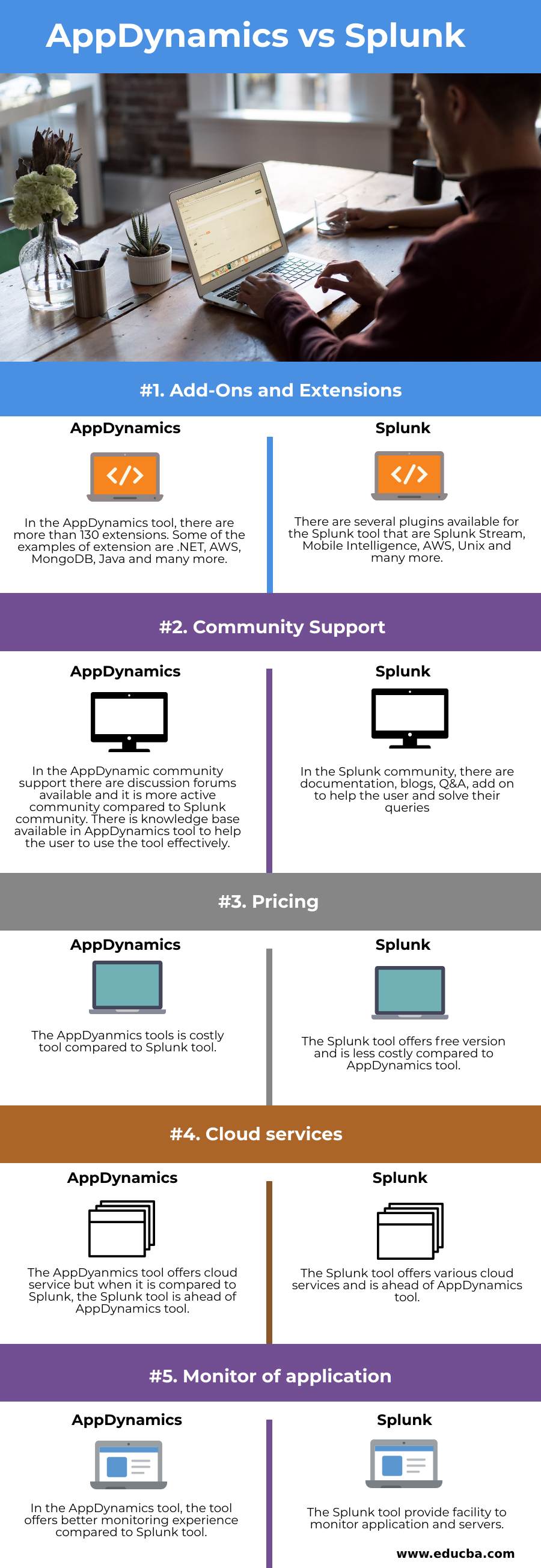Updated August 23, 2023
Difference between AppDynamics vs Splunk
AppDynamics vs Splunk, AppDynamics is defined as a tool that is used to monitor the transactions made in the application. This tool is mainly used in a production environment that helps to provide complete transaction details to the developers. The other use of the AppDynamics tool is the monitoring of the application. The other tool is the Splunk tool that is also used for the monitoring of application performance. The users have complete access to monitor performance and take appropriate actions. There are several differences between the two tools that are mentioned in the next section.
Head to Head Comparison between AppDynamics vs Splunk (Infographics)
Below are the top Comparisons between AppDynamics and Splunk.
Key differences of AppDynamics vs Splunk
Let us study some important key differences between AppDynamics and Splunk:
Application Monitoring
Both types of tools are used for application monitoring. But when we compare both the tools the better software is AppDynamics. The AppDynamics tool provides a better monitoring experience of the application and is also easy to use tool compared to the Splunk tool. There is an in-built function in the AppDynamics tool that detects the application automatically present on the network server and monitors the performance of the server. The monitoring process can be done at the granular level in the AppDynamics tool. In the Splunk tool, the machine learning algorithm is used for detecting patterns and then detecting the performance issues in the application. The current data usage can be calculated using the Splunk tool and prediction can be done for issues related to application performance.
Cloud monitoring
As the organization is heading towards cloud services there is always a need to monitor the cloud infrastructure. All the platforms that are used in application monitoring need to have the functionality to monitor the cloud infrastructure. Both tools are capable of providing this functionality to support cloud services monitoring. In the AppDynamics tool, the user can monitor the cloud service performance in real-time. The user can also monitor the throughput and transaction volume. On the other hand, in the Splunk tool, the user can manage the cloud services, hybrid services, and also mitigation of cloud from one location to another. When any performance issue is encountered user can troubleshoot with the help of the Splunk tool. The Splunk tool has the advanced feature in which users can monitor the cost of cloud resource consumption and plan the future requirements according to that thus it makes the Splunk tool ahead of the AppDynamics tool as this feature is not there in the Splunk tool.
Monitoring of server
In the modern networking era, monitoring servers is a primary requirement as many organizations concerned about their server health and ensure that they are always available. And for that the Splunk and AppDynamics. The AppDynamics tool provides the facility to check the health of servers and also monitor the performance and ensure that they are all well connected. And when any issue is pinpointed it can be immediately solved. The Splunk tool also provides the facility to ensure the health of servers and report for any issue if it is there. The tool is also capable of measuring the latency issue and load so that issues can be solved easily. Both of the tools offer a dashboard in which users can see the CPU Usage and log data. The statistics are displayed in the form of graphs so that a better idea can be provided regarding the performance of servers. The graph also shows the CPU % & ROI %. The main aim of the Splunk tool is to ensure that servers are always available. As the Splunk tool offers various features but still AppDynamics tool provides a better experience than the Splunk tool.
Autodiscovery
When we compare the AppDynamics tool and Splunk tool on the basis of Autodiscovery the AppDynamics tool always maintains the upper hand. The AppDynamics tool provides the facility to auto-discover and displays the visual connection that exists between the user. The complete network of the application can be easily displayed in the AppDynamics tool. On the other hand, this feature is not there in Splunk. The user cannot see the complete network and does not have visibility wherein AppDynamics users have this functionality.
Community Support
The support of the community for any product is very important to boost the performance of the application. Community support can help to understand the product better and also improve monitoring skills. In the AppDynamic community support, there are discussion forums available and it is a more active community compared to the Splunk community. There is a knowledgebase available in the AppDynamics tool to help the user to use the tool effectively. In the Splunk community, there are documentation, blogs, Q&A, add on to help the user and solve their queries. When we compared both tool communities on the basis of activeness the AppDynamics tool is ahead of Splunk but when we compare on the basis of better community support the Splunk community tool has better results.
Comparison Table of AppDynamics vs Splunk
Below is the comparison table:
| Factor | AppDynamics | Splunk |
| Add-Ons and Extensions | In the AppDynamics tool, there are more than 130 extensions. Some of the examples of the extension are .NET, AWS, MongoDB, Java, and many more. | There are several plugins available for the Splunk tool that are Splunk Stream, Mobile Intelligence, AWS, Unix, and many more |
| Community Support | In the AppDynamic community support, there are discussion forums available and it is a more active community compared to the Splunk community. There is a knowledgebase available in the AppDynamics tool to help the user to use the tool effectively. | In the Splunk community, there are documentation, blogs, Q&A, add on to help the user and solve their queries |
| Pricing | The AppDyanmics tool is a costly tool compared to the Splunk tool. | The Splunk tool offers a free version and is less costly compared to the AppDynamics tool. |
| Cloud services | The AppDyanmics tool offers cloud service but when it is compared to Splunk, the Splunk tool is ahead of the AppDynamics tool. | The Splunk tool offers various cloud services and is ahead of the AppDynamics tool. |
| Monitor of application | In the AppDynamics tool, tool offers a better monitoring experience compared to the Splunk tool. | The Splunk tool provides a facility to monitor applications and servers. |
Conclusion
The AppDynamics tool and Splunk tool are both powerful tools used for monitoring the application performance and if users want the best monitoring experience the AppDynamics tool is always the perfect solution. AppDynamics provide a better user experience compared to the Splunk tool. The selection of the right tool among the two is completely dependent on user requirements and the type of application for which the tool is used for.
Recommended Articles
This is a guide to AppDynamics vs Splunk. Here we discuss the difference between AppDynamics vs Splunk, key differences, and comparison table. You can also go through our other related articles to learn more –


